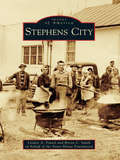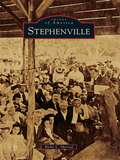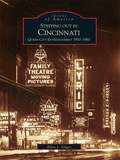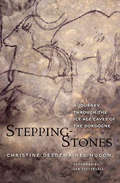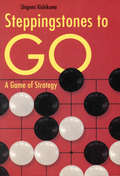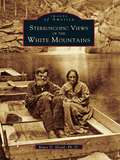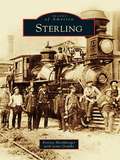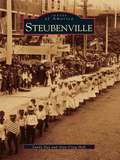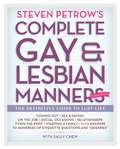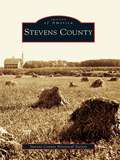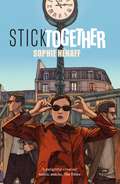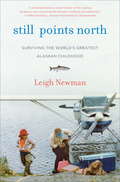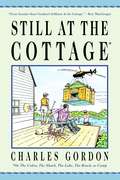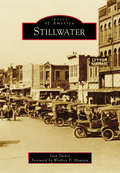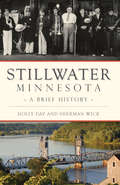- Table View
- List View
Stephens City (Images of America)
by Linden A. Fravel Stone House Foundation Byron C. SmithOn October 12, 1758, a newly appointed lieutenant governor of Virginia approved a set of bills passed by the colony's legislature, and the town of Stephens City, originally named Stephensburgh, was born. As the town grew over the next century and a half, its inhabitants participated in events of national significance, including the French and Indian War, the American Revolution, and the Civil War, when the town was almost burned by Union forces. Throughout its history, the town has had a reputation for labor, industry, thrift, and the overland travel and vehicle traffic associated with the modern U.S. Route 11 corridor. Where 150 years ago the town was famous for producing high-quality freight wagons, it is today a growing suburban community with residents who commute to work in the surrounding region.
Stephenville
by Ricky L. SherrodOn July 4, 1855, on the fringe of the Texas Cross Timbers frontier, John M. Stephen and George B. Erath completed the survey of the Stephenville city square. Stephenville quickly became a prosperous settlement and a center for cattle raising, cotton production, and most recently dairy production. Styled today as the "City of Champions," "Cowboy Capital of the World," and the "Dairy Capital of Texas," Stephenville has a colorful 155-year history. The evolution from cattle ranching to dairy farming finds delightful expression on the original town square where Moo-la--a life-size fiberglass Holstein milk cow--celebrates Stephenville's agricultural achievements. "The 'Ville" has produced football heroes such as 1938 NFL Champion New York Giants fullback Hugh Wolfe and 2010 Philadelphia Eagles quarterback Kevin Kolb and rodeo champions Whit Keeney, Tuff Hedeman, and "King of the Cowboys" Ty Murray. Music celebrities Lee Roy Parnell, Johnny Duncan, Larry Joe Taylor, and Jewel have also called Stephenville home.
Stepping out in Cincinnati: Queen City Entertainment 1900-1960
by Allen J. SingerLong before folks had a television set and radio in every room, they sought entertainment by stepping out for a night on the town. The choices around Cincinnati were nearly limitless: live theater at the Cox; spectacular musicals at the Shubert; hotels featuring fine dining and dance orchestras; talking pictures at everyone's favorite movie palace--the Albee; burlesque and vaudeville shows at the Empress Theater on Vine Street; and gambling casinos were just a short drive across the river in Newport. All of the major entertainment venues in the Queen City during the first half of the 20th century are explored in Stepping out in Cincinnati. From saloons to ornate movie palaces and from the Cotton Club to the Capitol, you join those pleasure seekers, getting a real sense of what they saw: wonderful events and their countless images--the things of which fond memories were made. Today, those memories have faded and virtually all of the once-glittering showplaces have been bulldozed into history. But within these pages, we get to experience first hand what it was like to be there. Unique among the many photographs featuring unforgettable movie houses and nightclub orchestras are never-before-published images of actual live vaudeville performances onstage at the Shubert, plus rare, clandestine pictures snapped inside the casinos in Newport. Also revealed are the locations of the better-known speakeasies during Prohibition; where the best halls to dance to live orchestras were; what the earliest movie houses were like; and what black Cincinnatians did for entertainment.
Stepping-Stones: A Journey through the Ice Age Caves of the Dordogne
by Christine Desdemaines-Hugon&“The next best thing to actually seeing the prehistoric cave art of southern Franc[e] . . . A rapturous guide through five major Ice Age sites&” (Archaeology). The cave art of France&’s Dordogne region is world-famous for the mythology and beauty of its remarkable drawings and paintings. These ancient images of lively bison, horses, and mammoths, as well as symbols of all kinds, are fascinating touchstones in the development of human culture, demonstrating how far humankind has come and reminding us of the ties that bind us across the ages. Over more than twenty-five years of teaching and research, Christine Desdemaines-Hugon has become an unrivaled expert in the cave art and artists of the Dordogne region. In Stepping-Stones she combines her expertise in both art and archaeology to convey an intimate understanding of the &“cave experience.&” Her keen insights communicate not only the incomparable artistic value of these works but also the near-spiritual impact of viewing them for oneself. Focusing on five fascinating sites, including the famed Font de Gaume and others that still remain open to the public, this book reveals striking similarities between art forms of the Paleolithic and works of modern artists and gives us a unique pathway toward understanding the culture of the Dordogne Paleolithic peoples and how it still touches our lives today. &“Her vivid descriptions help readers visualize the Cro-Magnon man or woman painting the beautiful bison, horses, mammoths, and other symbols. [A] fine reading experience.&” —Library Journal
Steppingstones to Go
by Shigemi KishikawaMr. Kishikawa's easy-to-follow book explains the fundamental principles of the game for the Westerner. From the basic rules of play, the author leads the reader in easy stages to the more advanced subtleties of go. Over a hundred diagrams, with twenty problems and answers, make this a complete introduction to one of the most fascinating and rewarding games in the world.
Stereoscopic Views of the White Mountains (Images Of America Ser.)
by Bruce D. HealdFor more than 150 years, the White Mountains have attracted untold numbers of visitors from all over the world. The lofty peaks offer unlimited panoramas the view from the summit of Mount Washington extends for more than 100 miles in all directions and includes 33 other mountaintops, each with an elevation exceeding 4,000 feet. Framing the Presidential Range are Crawford Notch, Franconia Notch, and Pinkham Notch, three of the most impressive wonders in the eastern part the country. The White Mountain region has numerous other points of interest: the Flume, the Pool, the Basin, the Old Man of the Mountain, Glen Ellis Falls, the Lake of the Clouds, Echo Lake, Profile Lake, and the White Horse Ledge, to name a few. The stereo technique dates from the earliest years of photography. Stereo photographs are two images of the same view taken from slightly different points, which when observed through special glasses appear as one with an added dimension of depth. Photographers took these three-dimensional views to exemplify and to preserve in print the beauty, wonders, and wealth of nature. Stereoscopic Views of the White Mountains contains more than 200 reflective stereos of the region's mountains, lakes, rivers, and streams. These breathtaking views of the landscape, the resorts, and the villages were taken during an excursion on the early railroads. They recall the romance and idealism of the rail and stagecoach era.
Sterling (Images of America)
by Forrest Hershberger Jenni GrubbsThe city of Sterling in northeast Colorado is at a crossroads of several trails historically and modern roads and highways today. The area was once inhabited by the Arapahoe, Cheyenne, Crow, Blackfoot, Sioux, Kiowa, and Pawnee tribes. The earliest Europeans were fur trappers on their way to the Colorado Mountains. The Sterling area is also noted for one of the final battles of the Indian wars, the battle of Summit Springs, between Tall Bull's Cheyenne Dog Soldiers and Col. Eugene A. Carr and the U.S. Army, southeast of Sterling on July 11, 1869. Today the city of Sterling is the county seat for Logan County. It is located at the junction of the South Platte River, Interstate 76, and Highways 6, 14, 61, and 138. Its history as an agricultural community is still a vital part of the economy and culture. Many of the celebrations seen in this book are annual events today, including the county fair and Sugar Beet Days.
Sterling Township: 1875-1968 (Images of America)
by Sterling Township Public Library and Historical CommisionSterling Township, located about 18 miles northeast of Detroit, was first settled after the Erie Canal was opened. The rich soil, relatively flat land, and the vital Clinton River attracted pioneer and immigrant families who arrived to establish farmsteads. The first influx of immigrants came mainly from the British Isles, and by the 1870s, Germanfamilies had flocked to the area, raising dairy cattle andestablishing farms. Belgians, arriving in the early 1900s,developed truck farming--growing fruits and vegetablesto sell every week at the farmers' market in Detroit. Farmculture prevailed until the 1950s, when large industrialplants began moving in, bringing with them workers anda need for housing and city services. Sterling Townshipbecame the city of Sterling Heights in 1968, and thiscollection of photographs will showcase the families andthe way of life in the early days of this community, ahistoric community that is now the fourth largest city in Michigan.
Steubenville (Images of America)
by Alan Craig Hall Sandy DayNamed after a Prussian officer who aided America during the Revolution, Fort Steuben was constructed in 1786 to protect government surveyors of the Old Northwest Territory. In 1797, Steubenville, one of the earliest settlements in Ohio, was founded and named after the fort. Located on the Ohio River, the town became a hub of transportation, bringing in settlers and industry. By the 20th century, Steubenville had become a center for steel production and coal mining. Important figures President Abraham Lincoln's Secretary of War Edwin M. Stanton, sports commentator "Jimmy the Greek," and entertainer Dean Martin all are natives of Ohio's eastern gateway, Steubenville.
Steven Petrow's Complete Gay And Lesbian Manners: The Definitive Guide To LGBT Life
by Steven Petrow Sally ChewFinally, the first big book of manners for the more than 15 million lesbian, gay, bisexual, and transgender people in the United States and Canada and the people who love them, work with them, and live with them. Written by Steven Petrow, the go-to authority on the subject-he's the same-sex wedding expert at The New York Times and a columnist for The Huffington Post, Yahoo's Shine, GayWeddings. com, and the "Q" Syndicate (with distribution to more than 100 LGBT newspapers and websites)-this is the definitive book of LGBT etiquette. Encyclopedic in its approach, filled with practical wisdom, lively wit, and much insight, Steven Petrow's Complete Gay & Lesbian Manners covers everything: from coming out to being out in the workplace; from dealing with the joy and complexity of same-sex weddings and commitment ceremonies (including how to propose and write meaningful vows) to handling the legal paperwork every couple needs. There's a chapter on sex etiquette, and another on the challenges and opportunities of raising a family, plus sections on travel, bullying, entertaining, meeting new friends, introducing your partner to your family, a primer on gay pride, and so much more. Throughout there are hundreds of questions-some posed by LGBT folk, and others by straight people: What do the mothers of two brides wear to a lesbian wedding? What do you say to an anti-gay joke? How do you answer "Who's the father?" when there are two mothers? Manners, yes, but with a twist. **In recognition of Quality, Excellence, and Design, this ebook has been granted a QED seal of approval from Digital Book World. **
Stevens County (Images of America)
by Stevens County Historical SocietyThe land area that came to be known as Stevens County was ceded to the United States government by the Dakota Indians in the treaty of the Traverse des Sioux in 1851. Government and railroad exploration parties, Red River Trail oxcarts, and pioneers and missionaries had come through the area long before it was officially ceded or settled. After the Dakota uprising of 1862, the United States government made the decision to put a fort in Dakota Territory. In 1864, Fort Wadsworth, later called Fort Sisseton, was built. Mule teams with supplies for soldiers and Native Americans, and pioneers began traveling in greater numbers across the tallgrass prairies of Stevens County from St. Cloud and into Dakota Territory. Pioneers from many different countries settled in Stevens County to break up the prairie sod and plant wheat and tree claims on their homesteaded land. Grasshoppers, prairie fires, and blizzards tested their determination, but the hardy ones survived to provide for their children's education, organize local governments, and build homes, churches, and businesses.
Stick Together
by Sophie HénaffAfter their successful solving of three cold cases and exposing corruption at the very highest level of the Paris police force, Anne Capestan's squad of misfits and no-hopers should be in a celebratory mood. However, now despised by their colleagues at 36 quai des Orfèvres and worried for their future, morale has never been lower among the members of the Awkward Squad.Capestan does her best to motivate her troops, but even she cannot maintain a cheerful façade when she has to investigate the murder of Commissaire Serge Rufus, the father of her ex-husband. Worse, it soon appears that his murder is linked to two other victims, both of whom were warned by the killer before they struck . . .
Stick Together
by Sophie HénaffAfter their successful solving of three cold cases and exposing corruption at the very highest level of the Paris police force, Anne Capestan's squad of misfits and no-hopers should be in a celebratory mood. However, now despised by their colleagues at 36 quai des Orfèvres and worried for their future, morale has never been lower among the members of the Awkward Squad.Capestan does her best to motivate her troops, but even she cannot maintain a cheerful façade when she has to investigate the murder of Commissaire Serge Rufus, the father of her ex-husband. Worse, it soon appears that his murder is linked to two other victims, both of whom were warned by the killer before they struck . . .
Stickeen
by John MuirA great dog story, a well-told tale -- the naturalist and adventurer John Muir recounts how he and his companion, a dog named Stickeen, each, alone, confronted and conquered their fears of an icy Alaskan glacier in 1880.
Still Points North
by Leigh NewmanPart adventure story, part love story, part homecoming, Still Points North is a page-turning memoir that explores the extremes of belonging and exile, and the difference between how to survive and knowing how to truly live.Growing up in the wilds of Alaska, seven-year-old Leigh Newman spent her time landing silver salmon, hiking glaciers, and flying in a single-prop plane. But her life split in two when her parents unexpectedly divorced, requiring her to spend summers on the tundra with her "Great Alaskan" father and the school year in Baltimore with her more urbane mother.Navigating the fraught terrain of her family's unraveling, Newman did what any outdoorsman would do: She adapted. With her father she fished remote rivers, hunted caribou, and packed her own shotgun shells. With her mother she memorized the names of antique furniture, composed proper bread-and-butter notes, and studied Latin poetry at a private girl's school. Charting her way through these two very different worlds, Newman learned to never get attached to people or places, and to leave others before they left her. As an adult, she explored the most distant reaches of the globe as a travel writer, yet had difficulty navigating the far more foreign landscape of love and marriage.In vivid, astonishing prose, Newman reveals how a child torn between two homes becomes a woman who both fears and idealizes connection, how a need for independence can morph into isolation, and how even the most guarded heart can still long for understanding. Still Points North is a love letter to an unconventional Alaskan childhood of endurance and affection, one that teaches us that no matter where you go in life, the truest tests of courage are the chances you take, not with bears and blizzards, but with other people.Praise for Still Points North "Newman has crafted a vivid exploration of a broken family. . . . Her pain will resonate strongly with readers, and she vividly brings both Alaska and Maryland to life. . . . A natural for book clubs."--Booklist "Newman's adult search for her own true home is riveting, as are her worldwide adventures; it's a joy to be in on the ride."--Reader's Digest"Leigh Newman writes so lucidly about bewilderment, so honestly about self-deception, so courageously about fear, so compassionately about insensitivity, so hilariously about suffering and loss. Still Points North is a remarkable book: a travel memoir of the mapless, dangerous seas and territories between childhood and adulthood."--Karen Russell, Pulitzer Prize finalist for Swamplandia! "Still Points North begins in the remote woods of Alaska and then travels around the world and back again, following the adventures of a girl adrift. Newman navigates her way through these vividly written pages with the strength and skill of a river guide, always keeping her bearings. And, like the salmon she and her father fish for in the wilderness, Newman makes her way past the traps and rapids of life to find her way back home."--Hannah Tinti, bestselling author of The Good Thief "At once harrowing and tender-hearted, Still Points North is a memoir that reminds us of the fragility of family architecture and of father figures as mysterious, heroic, flawed humans. Leigh Newman illuminates the power of domestic discord to become a literal struggle for survival, brilliantly drawing a picture of a child tumbling through her family's dissolution as she struggles to make sense of what family means."--A. M. Homes, bestselling author of The Mistress's DaughterFrom the Hardcover edition.
Still at the Cottage: Or the Cabin, the Shack, the Lake, the Beach, or Camp
by Charles GordonIn 1989, Charles Gordon wrote a book about the joys of life at the cottage called, well, At the Cottage. It was a huge success, selling thousands of copies every year since then. A copy sits, dog-eared and smeared with sunscreen, in every cottage worthy of the name, right beside the bird book with the missing pages. Now, showing the same creative spirit when it comes to names, comes Still at the Cottage. Readers will be surprised to learn that some things have changed in cottage country, which is now real estate. Suburbanism proceeds apace; the store at the dock now stocks lawncare items (this is bad). But it also stocks more fruits and vegetables (this is good). Gordon pokes affectionate fun at the surprising new technology available to people heading for the simple life at the cottage. He even proposes a solution to solve neighbour conflicts: some lakes should be zoned as napping lakes, others as jet ski lakes, others possibly as jerk lakes, and so on. Monster cottages may gobble up rocks and trees, and traffic on and to the lake may be much worse. But this book, like the slap of the screen door, will remind you instantly why the cottage is a special place that needs a copy of this very funny book.From the Trade Paperback edition.
Stillwater
by Stan Tucker Winfrey D. HoustonStillwater has been known across the nation as the place "where Oklahoma began." From the boomer camps to the Land Run of 1889, the city has a rich, vibrant history. The tenacity of its residents, though, is the reason Stillwater survived. While towns like Guthrie and Oklahoma City--which had railroads--recorded between 10,000 and 15,000 new residents on the first day of the Land Run, Stillwater could only muster a handful. Although it lacked amenities, Stillwater flourished in grit, hard work, and perseverance. After hard-fought battles to retain the Payne County seat and Oklahoma Agricultural and Mechanical College, Stillwater was here to stay. It may have once been proclaimed "where Oklahoma began," but it now has earned its place as "Stillwater, where Oklahoma's future belongs."
Stillwater, Minnesota: A Brief History (Brief History)
by Holly Day Sherman WickThe riverfront always drew people to Stillwater. The Ojibwe and Dakota first settled here, later striking a treaty with Europeans, who quickly realized the St. Croix River's potential as an ideal way to move lumber. One of the first to float logs down the river was Captain Stephen Hanks, cousin to Abraham Lincoln. The lumber business gave birth to Minnesota's first millionaire as the city grew, and Stillwater received one of the state's first Carnegie grants for a free public library. Meanwhile, the state prison saw notorious gangster Cole Younger found the Prison Mirror in 1887, now the nation's oldest continuously operated offender newspaper. Authors Holly Day and Sherman Wick celebrate the history and charm of one of Minnesota's finest cities, from the frontier to today.
Stink and the Great Guinea Pig Express (Stink #4)
by Megan McdonaldWhen three guinea pigs from the local pet shop make a great escape, Stink Moody and his friends Webster and Sophie spring into action. TA-DA! <P><P>The Fantastic Fur Friends round up the little hairballs and bring them safely back to Mrs. Birdwistle's shop, where they discover -- OH-LA-LA! -- guinea pig pandemonium! Time for the Great Guinea Pig Giveaway! <P><P>Stink and company hit the road in a crazy quest to find good homes for 101 squealing, whistling, chirping, wiggly piggies.
Stockholm Noir (Akashic Noir)
by Johan Theorin Åke Edwardson Nathan Larson Carl-Michael Edenborg Martin Holmén Lina Wolff Inger Frimansson Unni Drougge Inger Edelfeldt Torbjörn Elensky Carl Johan De Geer Malte Persson Anna-Karin SelbergNamed a Pick of the Week for the week of February 29th by Publishers Weekly"Grouped under three headings, the 13 stories in this outstanding entry in Akashic's noir series capture the gloomy underside of Sweden's capital, portraying the hopelessness of those trapped in what Larson and Edenborg in their introduction call the city that devours your soul."--Publishers Weekly, Starred review"Coedited by local authors Larson and Edenborg, this superb sampling of Swedish crime writing talent, some of whose work has been translated into English for the first time here, will be appreciated by fans of Stieg Larsson's 'Millennium' trilogy and Jens Lapidus's Easy Money; they will enjoy getting to know these authors, who write about Stockholm's dark side."--Library Journal"Akashic's multivolume Noir series returns to Scandinavia, focusing this time on the capital city of Sweden, a country that is famously neutral in time of war but is also a large-scale dealer in arms....Another worthy entry in this globe-trotting mystery series."--Booklist"Larson and Edenborg manage to unearth a dark side to a city that is verdant, clean, and surrounded by crystalline water....Stockholm may not be Marseille, but Larson and Edenborg's contributors show that even a verdant place with socialized medicine can have its seamy side."--Kirkus Reviews"The series offers the best of bite-sized crime stories from all over the world--you can't go wrong!"--Book Riot"On the heels of editions set in Copenhagen and Helsinki comes Stockholm Noir, edited by Nathan Larson and Carl-Michael Edenborg with a predictably discerning eye for stories that wring suspense, violence, and worry from social and political issues percolating in a given milieu."--Village VoiceAkashic Books continues its award-winning series of original noir anthologies, launched in 2004 with Brooklyn Noir. Each book comprises all new stories, each one set in a distinct neighborhood or location within the respective city.Brand-new stories by: Unni Drougge, Inger Edelfeldt, Carl-Michael Edenborg, Åke Edwardson, Torbjörn Elensky, Inger Frimansson, Carl Johan De Geer, Martin Holmén, Nathan Larson, Malte Persson, Anna-Karin Selberg, Johan Theorin, and Lina Wolff.From the introduction by Nathan Larson & Carl-Michael Edenborg:"To the tourist, the city of Stockholm appears a shimmering dream. Laid out on a series of islands, it is verdant, clean, and surrounded by crystalline water. On paper, Stockholm is paradise. And in some respects, it truly is. But in most respects, it is anything but...In Stockholm Noir, the city is presented as a gaping maw ready to devour your soul should you wander down the wrong alley...Everywhere is noir. Even, and especially, in a paradise like Sweden, where the citizen is given every tool to go out and become a great success but is paradoxically held to an almost subliminal expectation to fall in line...and never shine so brightly that you disturb your neighbor...In this anthology it's our aim to showcase the darker, grittier, more intense world of Swedish noir fiction. Here the dangers lurking beneath the IKEA lifestyle are given free rein, and words are given to the ambivalence and despair of a model society."
Stockton 99 Speedway
by Bill PoindexterFans have seen it all in 64 years of racing at Stockton 99 Speedway. The quarter-mile bullring on the east side of this rowdy port city in Northern California has been the site for 44 divisions of racing, from the Jalopy division of the 1950s to the all-time quickest lap in speedway history, which was wheeled by Johnny Brazil, a legendary local lead foot whose hot laps in a Super Modified fire breather on the night of June 1, 1985, left a normally boisterous gathering hypnotized in jaw-dropping silence as the scoreboard logged quick time after quick time, finally dipping under 12 seconds before bottoming out at 11.899. Stockton 99 has served as a stepping stone for a future Daytona 500 champion (Ernie Irvan) and as a Saturday-night getaway for local hot shoes who saved their pennies just to keep their rods running for the one thing they loved to do on a Saturday night: race. The old track flat-lined in 2006--at the age of 60, stricken by development--but was shocked back to life in 2009 and again is hosting races in the NASCAR Whelen All-American Series and the NASCAR K&N Pro Series West.
Stolen Figs: And Other Adventures in Calabria
by Mark RotellaAn effortlessly artful blend of travel book, memoir, and affectionate portrait of a peopleCalabria is the toe of the boot that is Italy—a rugged peninsula where grapevines and fig and olive trees cling to the mountainsides during the scorching summers while the sea crashes against the cliffs on both coasts. Calabria is also a seedbed of Italian American culture; in North America, more people of Italian heritage trace their roots to Calabria than to almost any other region in Italy.Mark Rotella's Stolen Figs is a marvelous evocation of Calabria and Calabrians, whose way of life is largely untouched by the commerce that has made Tuscany and Umbria into international tourist redoubts. A grandson of Calabrian immigrants, Rotella persuades his father to visit the region for the first time in thirty years; once there, he meets Giuseppe, a postcard photographer who becomes his guide to all things Calabrian. As they travel around the region, Giuseppe initiates Rotella—and the reader—into its secrets: how to make soppressata and 'nduja, where to find hidden chapels and grottoes, and, of course, how to steal a fig without actually committing a crime. Stolen Figs is a model travelogue—at once charming and wise, and full of the earthy and unpretentious sense of life that, now as ever, characterizes Calabria and its people.
Stolen Water
by W. Hodding CarterWhen the Comprehensive Everglades Restoration Plan went into effect during the Clinton administration, Florida's great grassy wilderness garnered a host of national attention -- and has since become a breeding ground for environmental dispute. What does it take to "save" a forest? How can it be preserved? Enter W. Hodding Carter. For an Outside magazine feature he's agreed to paddle the ninety-nine-mile waterway in Everglades National Park to examine the landscape from all angles -- physical, political, cultural, and very personal -- and get to the rock-bottom heart of the story. Stolen Water is the outgrowth of Carter's journey. Through investigative research, eyewitness accounts, and interviews with key players in the conservation controversy, Carter offers a rare portrait of a national treasure. Utterly important, and at times downright hilarious, Stolen Water is a classic American adventure tale, and an environmental parable for our time.
Stone Harbor Revisited (Images of America)
by Karen Jennings Donna Van HornIn 1722, Seven Mile Beach, covered in red cedar and holly, bayberry bushes and beach plums, was acquired by the Leaming family, who used it for grazing and whaling. Long undeveloped, the southern portion of the island was sold to the South Jersey Realty Company in 1907. The Risley brothers sold bonds to support their vision of a seaside resort serving the wealthy of Philadelphia. Dunes were leveled, roads laid out, and basins dredged, creating the ideal vacation destination. Grand hotels shared space with workmen's cottages, and businesses sprang up to serve the crowds who flocked to Stone Harbor. The maritime ties of the community are evident in the long history of the Yacht Club of Stone Harbor, which traces its beginnings to as early as 1895. The clubhouse, built in 1909 and standing on its original site, is host to sailing and social activities throughout the year.
Stone Mountain Park
by Tim HollisFor centuries, explorers and pioneers told of a place in Georgia where there was a gigantic mountain of solid granite resembling "a great gray egg lying half-buried on a vast plain." In time, Stone Mountain, 15 miles east of Atlanta, became a local landmark. In 1915, it was decided that the mountain's sheer north face would be a good spot to carve a lasting memorial to the lost cause of the Confederacy. This proved to be easier said than done. Before the project was completed, one of Georgia's top tourist attractions was established around Stone Mountain's base.
